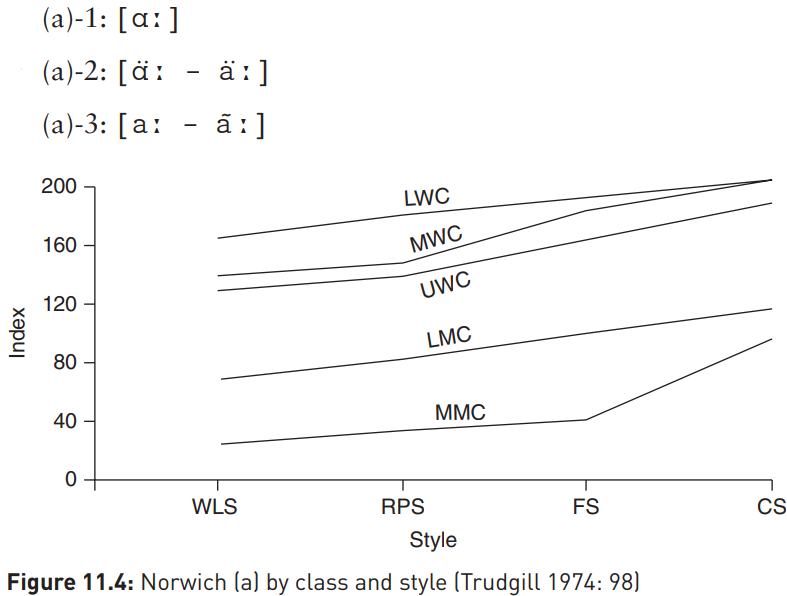
Variation by class and style
 المؤلف:
David Hornsby
المؤلف:
David Hornsby
 المصدر:
Linguistics A complete introduction
المصدر:
Linguistics A complete introduction
 الجزء والصفحة:
231-11
الجزء والصفحة:
231-11
 2024-01-01
2024-01-01
 1253
1253
Variation by class and style
A striking finding of both surveys was the very clear pattern of class stratification in speech: use of prestigious or standard variants by each social class mirrors exactly the hierarchy determined by the criteria for the social class index. This is true, moreover, in all styles, though differences are less pronounced in formal styles. Figure 11.3 shows class stratification for the (ng) variable in Norwich, for which variation affects the present participle and gerund suffix -ing. Again, two variants were identified: the standard velar nasal  ((ng)-1), and East Anglian vernacular
((ng)-1), and East Anglian vernacular  ((ng)-2) of hunt’n, shoot’n, fish’n stereotype. An index score for each speaker was then calculated on the basis of a score of 1 for tokens of (ng)-1, and 2 for each token of (ng)-2, the total being divided by the number of tokens. The results for each class in each style were then plotted on a graph:
((ng)-2) of hunt’n, shoot’n, fish’n stereotype. An index score for each speaker was then calculated on the basis of a score of 1 for tokens of (ng)-1, and 2 for each token of (ng)-2, the total being divided by the number of tokens. The results for each class in each style were then plotted on a graph:

Aside from the clear pattern of stratification across the five social classes Trudgill identified in Norwich (lower, middle and upper working class; lower and middle middle class), two points are noteworthy from this graph:
1 The fact that the lines slope in the same direction is indicative that, for this variable at least, Norwich forms a speech community on the basis of shared norms. While the social classes differ in their behavior, Norwich informants of all classes adjust their speech in the direction of more  use in formal styles.
use in formal styles.
2 The graph lines are quite steep for this variable, indicating a significant difference between formal and informal styles: the Norwich speech community is clearly aware of the social significance of this variable, and when given an opportunity to monitor their speech, informants make an effort to avoid the non-standard variant.
A variable like (ng) which shows a high degree of social and stylistic variation is called a marker. In some cases, a vernacular variant of a marker becomes so well known as to be the subject of overt mockery by outsiders: these stigmatized variants or stereotypes (for example ‘Bristol l’), are then avoided by all but lowest-status speakers. Indicators by contrast, show class stratification but relatively little stylistic differentiation. A good example, again from Norwich, is the (a) variable in words like after, cart, path for which the standard form is a back vowel, but vernacular variants are fronted:

As we can see from Figure 11.4, the variable (a) shows the familiar pattern of social stratification but the slopes are much flatter, because there is little difference between formal and informal styles. This suggests that, although the Norwich speech community agrees on what the ‘correct’ form is (the lines again all slope in the same direction), they do not perceive the variation to be socially significant in this case.
 الاكثر قراءة في Phonetics
الاكثر قراءة في Phonetics
 اخر الاخبار
اخر الاخبار
اخبار العتبة العباسية المقدسة


